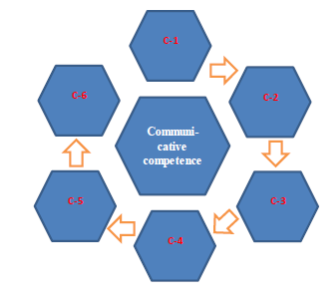The article actualizes the process of formation of communicative competence of the students of philological faculty, describing the effective mechanisms for the implementation of this process, namely the essence and content of the concept of «communicative competence», is a list of communicative competence, reveals the content of the methodology and describes the conditions for the implementation of this process.
Keywords: pedagogical conditions, communicative competence model, competence, competence technology, methods of forming
Global and dynamic historical, economic and political changes taking place in the last decade throughout the world have their influence on educational processes. At the present stage of development of our country we really are living in an open society, integrated into the culture of the world, the global economy and the world educational space. This, in turn, presupposes a fundamentally new requirements for the training of future teachers of philological direction.
The priority in the development of education in our country determined the problem, the main ones being to improve the quality of education, as well as the formation of the key and professional competencies of future professionals. Assessment of the current state of education and teacher training, prospects of development of the educational system, defined by the national strategy of education, indicate the need to put forward solutions of problems, one of the priorities of which performs the task of forming communicative competence.
Study of the problem of teacher training were engaged by many prominent scientists — S. I. Gusev, S. V. Ivanov, T. K. Markaryan, M. M. Rubinstein, L. M. Friedman; O. A. Abdullina, F. N. Gonobolin, J. K. Babanski, N. V. Kuzmina, I. J. Lerner, P. I. Pidkasisty, I. P. Podlasi, V. A. Slastenin, M. N. Skatkin and many others. As a result of these studies, enriched the theory of training, develop practical ways of its organization.
In our country, the problem of training of the future teacher educators studied by scientists in the context of the prospects for the development of higher education of our country: the formation of readiness of teachers ethno-aesthetical (A. A. Alimbekov), the formation of culture of international dialogue of schoolboys (N. A. Asipova), updating the higher education system (K. D. Dobaev), professional development of teachers during the development of innovative technologies of training at school (I. A. Nizovskaya), professional formation of ethnic culture of the future teacher (M. R. Rahimov) and others.
The study of scientific and educational literature, psychological and pedagogical periodicals showed the diversity of the studied concepts and a variety of definitions, which do not allow unambiguously reveal the qualitative definition of «competence» and is similar in content to his concept of " competence». The current research is often a substitution of these concepts. Of course, in some of these concepts are similar, but in any case, they are not equivalent and can not replace each other, since each of these concepts has its own interpretation of the definitions of some peculiarities. We give some definition tracts of «competence»:
‒ competence is a range of issues in which someone is aware; circle of someone's powers, rights. S. I. Ozhegov [1, p. 256];
‒ competence is a set of interrelated personality qualities (knowledge, skills, ways of life), defined with respect to a certain range of objects and processes necessary to efficiently and effectively operate in relation to them. A. V. Khutorski [5, p. 60];
‒ competence is confirmed as the readiness of the individuals (professionals) to use their full potential (knowledge, skills, experience and personal qualities) to be successful in a particular field, aware of its responsibility for its results. Y. G. Tatur [3, p. 171];
‒ competence is the learning outcomes-the formulation of what a learner should know, understand and demonstrate after the completion of the learning process; competence is a dynamic combination of ideology, knowledge and skills. Tuning: Tuning Educational Structures in Europe; Universities contribution to the Bologna Process; An introduction. — Socrates-Tempus. — 3 of p. [4];
‒ competence is a knowledge, awareness, authority in any area. S. I. Ozhegov [1, p. 256]
‒ the professional competence of teachers — is determined by the unity of its methodology, and the special psychological and pedagogical training. V. A. Slastenin [2, p. 298].
‒ competence is the ability to act on the basis of the knowledge gained. Unlike Zunov (assuming effect by analogy with the sample) competence involves the experience of independent activity on the basis of universal knowledge. S. E. Shishov, V. A. Kalnei [6].
Thus, definitions of data analysis, the main of which are presented above, led to the conclusion that due to the theoretical formulation of guidelines, from the standpoint that the authors examine the pedagogical reality. In this connection, in our research field we can say that a competence is a combination of knowledge, skills and the ability to exercise them in practice in the work and confirmed the readiness of the future teacher to realize their potential for success in the professional sphere.
Based on the methodological approaches such as the competency (the process of formation of the future expert is centered on the development and formation of competencies), activity (associated with understanding of activity as a basis, the means and the decisive conditions for the development of the individual, as a form of man with the environment of the active purposeful interaction) and system (characterized by unity and relationship of different structural elements, which are united by a common purpose and functioning), we developed a model of communicative competence of students of the Faculty of Philology (fig. 1), formulated a list of these competencies, the technique of their formation and identified effective pedagogical conditions of formation of communicative competence.

Fig. 1. The model of communicative competence
List of communicative competences set out by us:
C-1 — owns the techniques of communication equipment (lists and illustrates the methods of communication in the cluster technology; demonstrates knowledge, describing the nature and content of the concept «communicative technique»; demonstrates the ability to adjust the tone, pace, strength sound during communication).
C-2 — have the skills of interpersonal communication and interaction (lists the main characteristics of interpersonal communication and interaction; selection argues methods of interpersonal interaction, demonstrates the ability to establish communication between the partners in the dialogue).
C-3 — has the ability to regulate the social norms communication (lists the social norms of communication; illustrates an exemplary cluster of social norms of communication, shows in the communication range of a particular communication standards in relation to the society in which it exists).
C-4 — the ability to engage in constructive dialogue (describes the features of the constructive dialogue with the psychological positions; forecasts of constructive communication in the process of teaching activities; demonstrates the skills of constructive communication with people).
C-5 — the capacity for discernment partner in communication (knows the typology of personalities in communication, convincingly describes their personality characteristics, demonstrates the ability to interpret the human condition by their appearance: facial expressions, gestures, tone of voice, and so on.)
C-6 — have the skills of public speaking (lists the features of successful performance; schematically shows communication and dependency relationships successful performance; owns the techniques of constructive impact on the partners (audience) in communication; interprets the significance of nonverbal communication characteristics)
This our method of formation of communicative competence is represented by 4 stages: Stage I — preparation (consisted of the development of the seminar trainings for teachers of the faculty of philology «Formation of communicative competence at students of the Faculty of Philology.
Stage II — informative (at this stage has been studied the content of the educational process, namely EMC, i.e. educational-methodical complexes for students at philological disciplines, curriculum with a view to adapt to the educational process we have developed courses for teachers and students and implement them in the process of teaching and learning);
Stage III — Procedure (at this stage of the modernized teaching materials for philological disciplines, educational technologies developed seminars on formation of communicative competence have been introduced);
Stage IV — Diagnostic (at this stage determined the level of formation of communicative competence of C-1 — C-6 with our developed diagnostic methods and by analyzing and summarizing the results).
Important conditions for the formation of communicative competences we identified the following: methodical preparation of teachers of philological disciplines; update the content of literary education, motivation of teachers and students; reflection; introduction of educational technology training, which contribute to the formation of communicative competence; diagnosis of the level of formation of communicative competency.
Thus our conducted research allows to summarize the process of formation of communicative competence of students in the Faculty of Philology — a significant process in the preparation of competent teaching staff, which should be done from the standpoint of personality-oriented paradigm (which is based on a set of competency, the activity and systemic approaches) and with the creation of pedagogical conditions, compliance with which increases the efficiency of the process and the quality of entire education.
References:
- Ozhegov S. I. Dictionary of the Russian language. — M.: Russian language, 1981. — 816 p.
- Slastenin V. A. Pedagogy: Innovative activity / V. A. Slastenin, L. S. Podymova. — Moscow: Magistr, 1997. — 187 p.
- Tatur Yu.G. The general methodology for agreeing goals, structure and content in a system of general and professional design. — M.: IC of the problem of the quality of the training of specialists, 1997. — 51 p.
- Tuning Educational Structures in Europe // the process to the Bolon Process // An introduction. — Socrates — Tempus.
- Khutorsky A. V. Key competences of component of human-oriented paradigm // Nar. Obr-e. — 2003. — № 2. — P. 60.







